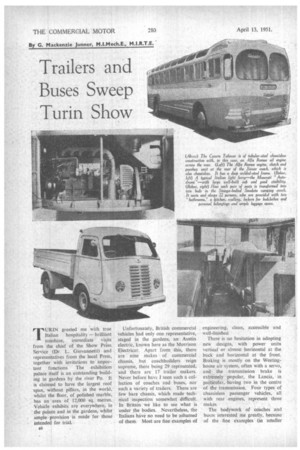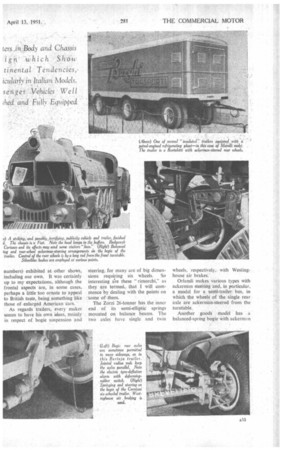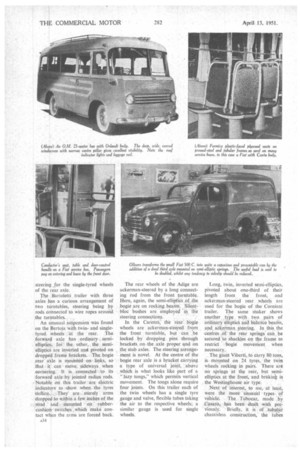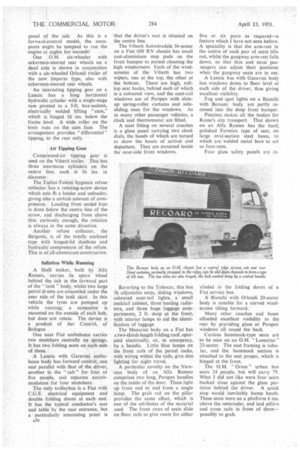Trailers and Buses Sweep Turin Show
Page 42

Page 43

Page 44

Page 45

Page 46

If you've noticed an error in this article please click here to report it so we can fix it.
TURIN greeted me with true Italian hospitality — brilliant
• sunshine, immediate visits from the chief of the Show Press Service (Dr L. Giovannetti) and representatives from the local Press, together with invitations to important functions The exhibition palace itself is an outstanding building in gardens by the river Po. It is claimed to have the largest roof span, without pillars, in the world, whilst the floor, of polished marble, has an area of 12,000 sq. metres. Vehicle exhibits are everywhere, in the palace and in the gardens, whilst ample provision is made for those intended for trial.
0 Unfortunately, British commercial vehicles had only one representative, staged in the gardens, an Austin electric, known here as the Morrison Electricar. Apart from this, there are nine makes of commercial chassis, but coachtmilders reign supreme, there being 29 represented, and there are 17 trailer makers. Never before have I seen such a collection of coaches and buses, nor such a variety of trailers. There are few bare chassis, which made technical inspection somewhat difficult. In Britain we like to see what is under the bodies. Nevertheless, the Italians have no need to be ashamed of-them. Most are fine examples of engineering, clean, accessible and well-linished There is no hesitation in adopting new designs, with power units vertical or almost horizontal at the back and horizontal at the front. Braking is mostly on the Westinghouse air system, often with a servo, and the transmission brake is extremely popular, the Lancia, in particular, having two in the centre of the transmission. Four types of chassisless passenger vehicles, all with rear engines, represent three makes.
The bodywork of coaches and buses interested me greatly, because of the fine examples {in smaller numbers) exhibited at other shows, including our own. It was certainly up to my expectations, although the frontal aspects are, in some cases, perhaps a little too ornate to appeal to British taste, being something like those of enlarged American cars. '
As regards trailers, every maker seems to have his own ideas, mainly in respect of bogie suspension and steering, for many arc of big dimensions requiring six wheels. So interesting are these " rimorchi," as they are termed,. that I will commence by dealing with the points on some of them.
The Zorzi 26-tonner has the inner end of its semi-elliptic springs mounted on balance beams. The two axles have single and twin
wheels, respectively, with Westinghouse air brakes.
Orlandi makes various types with ackerman steering and, in particular, a model for a semi-trailer bus, in which the wheels of the single rear axle are ackerrnan-steered from the turntable.
Another goods model has a balanced-spring bogie with ackerman
steering for the single-tyred wheels of the rear axle.
The Bartoletti trailer with three axles has a curious arrangement of two turntables, steering being by rods connected to wire ropes around the turntables.: , An unusual stispension was found on the Bertoja with twinand singletyred wheels at the rear. The forward axle has ordinary., semieliiptics; for the other, the semielliptics are inverted and pivoted on dropped frame brackets. The bogie rear" axle is mounted on links, so that • it can move, sideways when cornering. It is connected. •to its forward axle by jointed radius rods. Notable on this trailer are electric indicators to :show when. the tyres deflate.; :They' are merely arms dropped to within a few inches of the itad andmounted on rubbercushionswitches which make contact when the arms are forced back.
A34
The rear wheels of the Adige are ackerman-steered by a long connecting rod from the front turntable. Here, again, the semi-elliptics,61..the ,bogie are on rocking beams: ;Silentbloc bushes are employed: in the
steering connections: "
In the Carenzi; the 'rear. bOgie . wheels are ackerman-steered from , the front turntable, bilt can ' be locked by dropping. pins through brackets on•the.axle .proper and on the stub axles. The steering arrangement is novel. At the centre of the bogie rear axle is a bracket carrying a type of universal joint, _abovc which is what looks like part of a "lazy tongs," which permits vertical movement. The tongs alone require four joints. On this trailer each of the twin wheels has a single tyre gauge and valve, flexible tubes taking the air to the respective wheels; a similar gauge is used for single wheels. Long, twin, inverted seini-ellipties, pivoted about one-third of their length from the front, and ackerman-steered rear. wheels are used for the bogie of the Corniani trailer. The same Maker shows another .type , with., two, pairs _of ordinary elliptic§ an balanee bearns, and, ack_erman steering,. In this he centres of ' the rear springs can be secured .to shackles on the.frame to restrict bogie movement when necessary.
The, giant Viberti, to carry 80: tons, ismounted on 24 tyres, the twin wheels making .in pairs. There are no springs at the rear, but semielliptics at the front, and brakin is the Westinghouse air type.
Next of interest, to me, atleast, were the More unusual • types of
vehicle. The. Tubocar, made by sCasaro,, has been dealt with preViously. Briefly, it is of .tubular chassisless construction, the tubes being mainly of square section with round sections at a few points. It is electrically welded throughout, and in the standard model has an Alfa Romeo vertical engine, clutch and gearbox unit across the back, with the transmission brake at right angles. In the latest model, however, 'Which may have arrived at the Show, but which I inspected in the works, use is made of a Fiat engine, normally vertical, but modified by Casaro with a new sump, etc., to allow for fitting at an angle of 15 degrees from ihe horizontal. This permits a row of seats to be placed above it instead of the normal platforth for luggage. Most of the controls, in this case, are hydraulic.
• Another vehicle of this type is the " Siccar," made by Sicca. This, again, has an Alfa Romeo unit at the rear, and it is displayed as a chassisless frame without panelling. It is of steel " girder " construction, welded, but not tubular, and most of the controls are taken by rods from front to rear.
An Advertising Novelty
The most spectacular exhibit is a Fiat and trailer with Coriasco body, built to resemble a locomotive and tender, and finished in gold. The whole front of the "boiler " forms the windscreen, and much of the front being of glass, visibility is good. Headlamps are incorporated in the buffers. , It is a striking advertising novelty, but, I would-imagine, rather terrifying to meet on the road, Our illustration shows how well the representation is carried out.
For the enjoyment of the workers of a big weaving concern is a Fiat model 68ORN, with body by Stanga. It is described as a camping coach and has 22 seats, transformable into
22 reasonably comfortable beds. The back of each seat hinges up and meets that of the facing seat. Long bars slide from one to the other,. locking them together. The seats proper slide back to allow room for the extra cushions forming the lower .bed, each seat. normally having two of these cushions. The arrangement is quite solid, but I queried the safety of the occupants of the upper beds,• who would have a long way to fall, as there appeared to be no side protection beyond that given by the bedclothes. In normal use the seats, with their high backs, are quite comfortable, and the armrest cushions roll over to permit the lifting of hinged brackets which carry tables. There is a drop window beside each pair of seat-beds, lockers along the sides under the roof—one open for bedding and the other with a lock—and curtains on rails. .
The outfit is really a vehicle and trailer built on the Snodato principle under. Viberti licence and arranged rather in the fashion of a corridor train, with rubber jointing panels. On the circular platform between the two portions is a compartment for shower-bath and wash-basin, a second equipped as a kitchen, with gas fuel, and a third as a washing-up department with sink, etc. A second shower-room is at the front of the trailer portion. There are two large cupboards for food, external doors leading to large luggage compartments, and a bed for the driver.
. An Alfa Romeo has a special body by Borsani. It is a forward-control model, built as a saloon for demonstrating Heidelberg printing machines. Behind the engine is an electric motor for driving these, and around the back is a lounge seat with a table in front.
A little Maserati has been developed for .town delivery service at 20 m.p,h.The. engine is a twocylindered two-stroke in unit with a four-speed gearbox, and ample room is given' in the forward-control cab, with its petrol tank on the dash. This type can also be supplied as a battery-electric.
A special Borsani body on a small O.M. has the cab and rear part. of the body joined by a top central ridge. From this, curtains can be slid down channels to the low sides, each of which can also be dropped when required by turning a central handle. In. its open form the curtains are strapped to the centre ridge.
• Rear-engined Coach • The interesting Krauss-Maffei coach, in this case with a sixcylindered vertical oil engine at the rear, arranged longitudinally, is on view. Luggage space is provided above the engine. This is a different model from that displayed at Geneva.
A Lancia coach with Rimorchi body 'resembles our airways coaches in having a stepped roof with a windscreen on the step, so that occupants in the raised seats towards the rear obtain a reasonable view. Behind the stepped portion, however, is. a dropped section, forming a rear observation saloon, and the gangway, which passes right through, is stepped up . and down accordingly. Between the first and raised section are, at one side, a lavatory and at the other a small railed space and seat for the courier. Ample baggage space is, of course, afforded.
Another O.M. has a bed at floor level behind the driver's 'seat, whilst a second bed is hinged to the rear
panel of the cab. As this is a forward-control model, the occupants might be tempted to run the engine at nights far, warmth!
One O.M. six-wheeler with ackerman-steered rear wheels on a dead axle is shown in conjunction with a six-wheeled Orlandi trailer of the new lmperio type, also with ackerman-steered rear wheels.
An interesting tipping gear on a Lancia has a long horizontal hydraulic cylinder with a single-stage ram pivoted to a 5-ft. box-section, electrically welded 'lifting "cam," which is hinged 16 ins, below the frame level. A wide roller on the body runs on the cam ;face. The arrangement provides "differential" tipping, to the rear only.
Air Tipping Gear Compressed-air tipping gear is used on the Viberti trailer. This has three enormous cylinders on the centre line; each is 16 ins, in diameter.
The Tudini-Tale.nti hygienic refuse collector has a rotating-screw device which acts gs a loader and unloader, giving also a certain amount of compression. Loading from sealed bins is done below the centre line of the screw, and discharging from above this; curiously enough, the rotation is always in the same direction.
Another refuse collector, the Bergomi, is of the totally enclosed type with hinged-lid dustbins and hydraulic compression of the refuse. This is of all-aluminium construction.
Inflation While Running A Shell tanker, built by Alfa Romeo, carries its spare wheel behind the cab in the forward part of the "tank" body, whilst two large petrol drums are concealed under the near side of the tank skirt. In this vehicle the tyres are pumped up while running; a connector is mounted on the outside of each hub, but does not rotate. The device is a product of Aer Control, of Bologna One neat Fiat ambulance carries two stretchers centrally on springs. It has two folding seats on each side of these.
A Lancia with Garavini ambulance body has forward control, one seat parallel with that of the driver, another in the "cab" for four or five people, and separate accommodation for four stretchers.
The only trolleybus is a Fiat with C,G.E. electrical equipment and double folding doors at each end. It has the typical conductor's seat and table by the rear entrance, but a particularly interesting point is that the driver's seat is situated on the centre line.
The Viberti Autostradale 36-seater on a Fiat 680 RN chassis has small cast-aluminium step pads on the front bumper to permit cleaning the high windscreens. Each of the windscreens of the Viberti has two wipers, one at the top, the other at the bottom. There are high, rolltop seat backs, behind each of which is a coloured view, and the cant-rail windows are of Perspex with slideup spring-roller curtains and sidesliding ones for the windows. As in many other passenger vehicles, a clock and thermometer are fitted.
A -neat fitting on several coaches is a glass panel carrying two clock dials, the hands of which are turned to show the hours of arrival and departure. They are mounted inside the near-side front windows.
Reverting to the Tubocar, this has 36 adjustable seats, sliding windows, coloured cant-rail lights, a small cocktail cabinet, three' heating radixtors, and three huge' luggage compartments, 2 ft. deep at the front, with interior lamps to aid the identification of luggage.
The Menarini body on a Fiat has a two-thirds length folding roof, operated electrically, or, in emergency, by a handle. Little blue lamps on the front rails of the parcel racks, with wiring within the rails, give dim lighting for night travel.
A particular novelty on the Varesina body of an Alfa Romeo comprises two long. Perspex handles on the inside of the door. These light up from end to end from a single lamp. The grab rail on the pillar provides the same effect, which is one of the attributes of the material used. The front rows of seats slide on floor rails to give room for either five or six pairs as required—a feature which I have not seen before. A speciality is that the arm-rest in the centre of each parr of seats lifts out, whilst the gangway arm-rest falls down, so that thin and stout passengers can adjust their positions when the gangway seats are in use.
A Lancia bus with Garavini body has, windows down to floor level at each side of the driver, thus giving excellent visibility.
Fog and spot lights on a Bianchi with Borsani body are partly recessed into the deep front bumper.
Pistoiesi makes all the bodies for Rome's city transport. That shown on an Alfa Romeo has the hard, polished Formica type of seat, on large oval-section steel bases, to which are welded metal bars to act as foot-rests.
Four glass safety panels are in eluded in the folding doors of a Fiat service bus.
A Bianchi with Orlandi 20-seater body is notable for a curved windscreen tilting forward.
Many other coaches and buses afforded excellent visibility to the rear by providing glass or Perspex windows all round the back.
Curious hammock-type seats are to be seen on an O.M. "Leoncino " 23-seater. The seat framing is tubular, and the hammock section is attached to the seat proper, which is hinged at the front.
The O.M. " Orion " urban bus seats 24 people, but will carry 79. What I did not like were four seats backed close against the glass partition behind the driver. A quick stop would inevitably bump heads. These seats were on a platform 6 ins. above the remainder, and had pillars and cross rails in front of them— possibly to grab.












































































